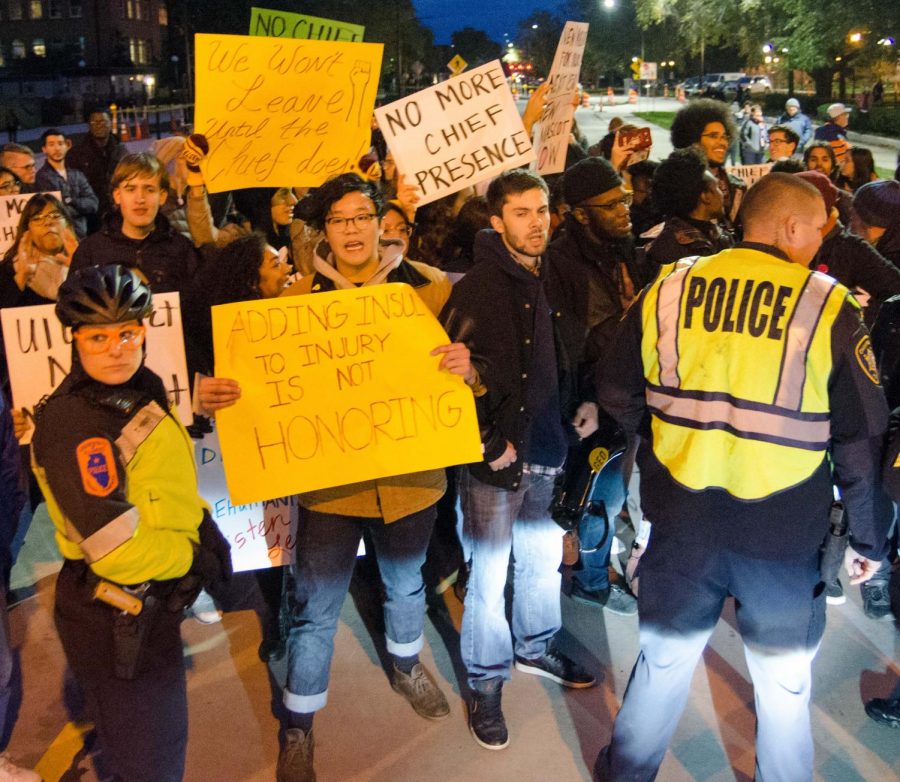Be smart in your protests
Anti-Cheif Illinwek protestors faced police officers on the corner of Wright and Green streets. The protest was organized by the Illinois Student Government and included other student organizations.
Nov 7, 2017
Last week was the annual Homecoming Parade, and because I was shooting some footage for the Daily Illini Youtube channel (like and subscribe if you haven’t already), I went to go see it. It was a pretty large gathering of people with families as the majority of attendees, since clubs and people on the floats were handing out candy to kids in the crowd.
While recording the parade, everything was going along smoothly: the plethora of Corvettes rolled down Wright Street, ROTC was looking sharp as usual and the dance teams were all shivering while performing their routines. However, there was a noticeable delay in the middle of the parade, when everyone just stopped for about 10 minutes. Then the parade moved on.
I thought nothing of it until I saw later on, from the Daily Illini snapchat (@thedailyillini), that there was a protest because the Chief was making an appearance at the parade.
For controversial topics at school, I usually take the following stance: if it doesn’t affect me directly, my opinion is neutral.
You can interpret this as being ignorant, apathetic or influenced by “The Stranger” by Albert Camus, but as a student with a full class schedule in addition to clubs and extracurriculars, most of the controversial topics aren’t at the top of my list of priorities.
Get The Daily Illini in your inbox!
However, for this specific incident and the Letter to the Editor that was published afterward, I have some advice to protesters: be proactive.
Actions speak louder than words, and when two people with strong contrasting opinions are arguing with one another, it’s highly unlikely that either of them will yield and change their stance. However, if one provides ways to compromise and encompass both opinions, then instead of arguing with each other, the two can work together toward a solution.
In the case of the protest at the Homecoming Parade, actions were ineffective, since nothing really changed afterward. The protesters did manage to get the Chief mascot to leave, which is cool and all, but the main reason that the Chief was removed from the parade was because everyone at the parade was freezing and impatiently waiting for it to continue.
According to Joey Domanski, vice president of the Illinois Student Government, the main reason for the protest was “because of the silence of the University administration.”
But, when watching videos of the protest, all you can hear are people chanting, “Not our mascot!” This simple phrase doesn’t explicitly explain the reason why they were protesting, so to a bystander, the protest seemed like just a bunch of people hating on the Chief.
After the parade, the Chief was physically gone, but there’s nothing stopping him from reappearing in the next parade. The protest was more or less a reaction to the minor problem of the Chief being in the parade rather than a step toward fixing the overarching issue: the school needs a new, politically correct mascot.
It has been 10 years since the ban of the Chief, and the school still doesn’t have a mascot. Instead of protesting the Chief at the Homecoming Parade, where the audience was mainly children, the hundreds of protesters should come together to present an alternative mascot that they consider acceptable. Then, progress could be made in fixing the issue.
Overall, if you’re going to protest anything, make sure that the entire point of the protest is clear in its execution and expected result. If the end result is a lot of noise and fifteen seconds of fame, was the protest really worth gathering a few hundred people to the same spot for an hour? I think there are better ways to communicate.
Brian is a junior in Engineering.






